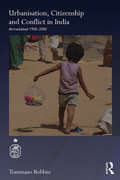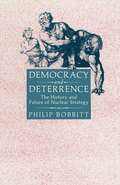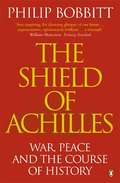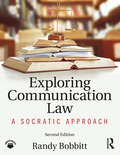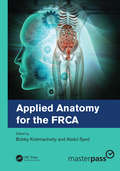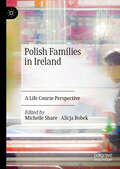- Table View
- List View
Urbanisation, Citizenship and Conflict in India: Ahmedabad 1900-2000 (Royal Asiatic Society Books)
by Tommaso BobbioUrbanisation is rapidly changing the geographic and social landscape of India, and indeed Asia as a whole. Issues of collective violence, urban poverty and discrimination become crucial factors in the redefinition of citizenship not only in legal terms, but also in a cultural and socio-economic dimension. While Indian cities are becoming the centres of a culture of exclusion against vulnerable social groups, a long-term perspective is essential to understand the patterns that shaped the space, politics, economy and culture of contemporary metropolises. This book takes a critical, longer-term view of India’s economic transition. The idea that urban growth goes hand in hand with the modernisation of the country does not account for the fact that increasingly higher portions of the urban population are comprised of lower-income groups, casual labourers and slum dwellers. Using the case study of Ahmedabad, this book investigates the history of city and of its people over the twentieth century. It analyses the contrasting relationship between urban authorities and the inhabitants of Ahmedabad and examines instances of antagonism and negotiation – amongst people, groups and between the people and the public authority – that have continuously shaped, transformed and redefined life in the city. This book offers an important tool for understanding the bigger context of the conflicts, the social and cultural issues that accompanied the broader process of urbanisation in contemporary India. It will be of interest to scholars of Urban History, studies of collective violence and South Asian Studies.
Urbanisation, Citizenship and Conflict in India: Ahmedabad 1900-2000 (Royal Asiatic Society Books)
by Tommaso BobbioUrbanisation is rapidly changing the geographic and social landscape of India, and indeed Asia as a whole. Issues of collective violence, urban poverty and discrimination become crucial factors in the redefinition of citizenship not only in legal terms, but also in a cultural and socio-economic dimension. While Indian cities are becoming the centres of a culture of exclusion against vulnerable social groups, a long-term perspective is essential to understand the patterns that shaped the space, politics, economy and culture of contemporary metropolises. This book takes a critical, longer-term view of India’s economic transition. The idea that urban growth goes hand in hand with the modernisation of the country does not account for the fact that increasingly higher portions of the urban population are comprised of lower-income groups, casual labourers and slum dwellers. Using the case study of Ahmedabad, this book investigates the history of city and of its people over the twentieth century. It analyses the contrasting relationship between urban authorities and the inhabitants of Ahmedabad and examines instances of antagonism and negotiation – amongst people, groups and between the people and the public authority – that have continuously shaped, transformed and redefined life in the city. This book offers an important tool for understanding the bigger context of the conflicts, the social and cultural issues that accompanied the broader process of urbanisation in contemporary India. It will be of interest to scholars of Urban History, studies of collective violence and South Asian Studies.
Constitutional Fate: Theory of the Constitution
by Philip BobbittHere, Philip Bobbitt studies the basis for the legitimacy of judicial review by examining six types of constitutional argument--historical, textual, structural, prudential doctrinal, and ethical--through the unusual method of contrasting sketches of prominent legal figures responding to the constitutional crises of their day.
Constitutional Fate: Theory of the Constitution
by Philip BobbittHere, Philip Bobbitt studies the basis for the legitimacy of judicial review by examining six types of constitutional argument--historical, textual, structural, prudential doctrinal, and ethical--through the unusual method of contrasting sketches of prominent legal figures responding to the constitutional crises of their day.
The Garments of Court and Palace: Machiavelli and the World that He Made (Books That Shook The World)
by Philip BobbittThe Prince, a political treatise by the Florentine public servant and political theorist Niccolo Machiavelli, is widely regarded as the most important exploration of politics - and in particular the politics of power - ever written.In Garments of Court and Palace, Philip Bobbitt, a preeminent and original interpreter of modern statecraft, presents a vivid portrait of Machiavelli's Italy and demonstrates how The Prince articulates a new idea of government that emerged during the Renaissance. Bobbitt argues that when The Prince is read alongside the Discourses, modern readers can see clearly how Machiavelli prophesied the end of the feudal era and the birth of a recognizably modern polity. As this book shows, publication of The Prince in 1532 represents nothing less than a revolutionary moment in our understanding of the place of the law and war in the creation and maintenance of the modern state.
The Shield of Achilles: War, Peace and the Course of History
by Philip BobbittThis ambitious book sets out to reinterpret the history of the twentieth century as a long war in which conditions of outright military confrontation or of frantic "cold" competition lasted from the outbreak of the first world war until the collapseof the Soviet Union. He goes on to argue that this long experience of war has brought about a fundamental change in the constitutional basis of sates, and explores this idea through the notion of the "market state". By clarifying the relationship between constitutional settlements and military power, and by drawing on his firsthand experience in the heart of superpower planning, Bobbitt reveals a startling new way of understanding the past - and an awesome glimpse of the future.
Terror and Consent: The Wars for the Twenty-first Century
by Philip BobbittThe wars against terror have begun, but it will take some time before the nature and composition of these wars is widely understood. The objective of these wars is not the conquest of territory, or the silencing of any particular ideology, but rather to secure the necessary environment for states to operate according to principles of consent and make it impossible for our enemies to impose or induce states of terror. Terror and Consent argues that, like so many states and civilizations in the past that suffered defeat, we are fighting the last war, with weapons and concepts that were useful to us then but have now been superseded. Philip Bobbitt argues that we need to reforge links that previous societies have made between law and strategy; to realize how the evolution of modern states has now produced a globally networked terrorism that will change as fast as we can identify it; to combine humanitarian interests with strategies of intervention; and, above all, to rethink what 'victory' in such a war, if it is a war, might look like - no occupied capitals, no treaties, no victory parades, but the preservation, protection and defence of states of consent. This is one of the most challenging and wide-ranging books of any kind about our modern world.
US Nuclear Strategy: A Reader
by Philip BobbittSetting the terms for an effective public debate on nuclear issues, this provides essays and excerpts from longer works that have charted the development of American nuclear strategy. Each section ends with questions for study and analysis with suggested further reading.
Exploring Communication Ethics: A Socratic Approach
by Randy BobbittExploring Communication Ethics is a comprehensive textbook on the ethical issues facing communication professionals in today&’s rapidly changing media environment. Empowering students to respond to real-world ethical dilemmas by drawing upon philosophical principles, historical background, and the ethical guidelines of major professional organizations, this book is designed to stimulate class discussion through real-world examples, case studies, and discussion problems. Students will learn how to mediate between the best interests of their employers and their responsibilities toward other parties, and to consider how economic, technological, and legal changes in their industries affect these ethical considerations. It can be used as a core textbook for undergraduate or graduate courses in communication or media ethics, and provides an ideal supplement for specialist classes in public relations, professional communication, advertising, political communication, or journalism and broadcast media.
Exploring Communication Ethics: A Socratic Approach
by Randy BobbittExploring Communication Ethics is a comprehensive textbook on the ethical issues facing communication professionals in today&’s rapidly changing media environment. Empowering students to respond to real-world ethical dilemmas by drawing upon philosophical principles, historical background, and the ethical guidelines of major professional organizations, this book is designed to stimulate class discussion through real-world examples, case studies, and discussion problems. Students will learn how to mediate between the best interests of their employers and their responsibilities toward other parties, and to consider how economic, technological, and legal changes in their industries affect these ethical considerations. It can be used as a core textbook for undergraduate or graduate courses in communication or media ethics, and provides an ideal supplement for specialist classes in public relations, professional communication, advertising, political communication, or journalism and broadcast media.
Exploring Communication Law: A Socratic Approach
by Randy BobbittBased on the Socratic dialogue method, Talking about Communication Law provides the fundamentals for discussing controversial issues in communication law and asks thought-provoking questions to promote debate. Providing the basic framework of the law with discussions focusing on the major cases in each area, Talking about Communication Law begins with the material related to the First Amendment's free speech and free press clauses, then proceeds through the various topics derived from those freedoms, including libel, privacy, access to information, the media and the courts, broadcast regulation, intellectual property, and business communication. Conciseness and clear language are its strengths, as are its readability and engaging approach. Point-counterpoint essays, frequently asked questions, chapter glossaries, and case problems encourage students to take an active approach to learning and create a running dialogue with the reader. The first one-third of the book deals with the First Amendment as applied to political speech, campus issues, and sexual expression. The second one-third deals with issues in journalism, broadcasting, and cyberspace.The last one-third deals with issues related to communication in business, such as advertising, public relations, and intellectual property.
Exploring Communication Law: A Socratic Approach
by Randy BobbittBased on the Socratic dialogue method, Talking about Communication Law provides the fundamentals for discussing controversial issues in communication law and asks thought-provoking questions to promote debate. Providing the basic framework of the law with discussions focusing on the major cases in each area, Talking about Communication Law begins with the material related to the First Amendment's free speech and free press clauses, then proceeds through the various topics derived from those freedoms, including libel, privacy, access to information, the media and the courts, broadcast regulation, intellectual property, and business communication. Conciseness and clear language are its strengths, as are its readability and engaging approach. Point-counterpoint essays, frequently asked questions, chapter glossaries, and case problems encourage students to take an active approach to learning and create a running dialogue with the reader. The first one-third of the book deals with the First Amendment as applied to political speech, campus issues, and sexual expression. The second one-third deals with issues in journalism, broadcasting, and cyberspace.The last one-third deals with issues related to communication in business, such as advertising, public relations, and intellectual property.
Exploring Communication Law: A Socratic Approach
by Randy BobbittExploring Communication Law, Second Edition, provides an overview of the law as it pertains to print, broadcast, and online journalism, as well as non-journalistic forms of expression. It begins by introducing students to the First Amendment in a general sense, then explores how the principles of free speech are applied in various circumstances, such as political speech, sexual expression, and K-12 and college campuses. The text also explains the fundamentals of media law in areas such as defamation, privacy, the media and the courts, confidentiality and privilege, access to information, broadcasting, and cyberspace.
Exploring Communication Law: A Socratic Approach
by Randy BobbittExploring Communication Law, Second Edition, provides an overview of the law as it pertains to print, broadcast, and online journalism, as well as non-journalistic forms of expression. It begins by introducing students to the First Amendment in a general sense, then explores how the principles of free speech are applied in various circumstances, such as political speech, sexual expression, and K-12 and college campuses. The text also explains the fundamentals of media law in areas such as defamation, privacy, the media and the courts, confidentiality and privilege, access to information, broadcasting, and cyberspace.
Buka's Emergencies in Dermatology
by Bobby Buka, Annemarie Uliasz and Karthik KrishnamurthyThis book offers thorough coverage of emergencies in dermatology, from the basics of critical care for dermatologic emergencies, to neonatal and pediatric emergencies, infectious emergencies, drug eruptions and HIV-AIDS-related emergencies, among many others.
Applied Anatomy for the FRCA
by Bobby Krishnachetty and Abdul SyedApplied Anatomy for the FRCA covers the anatomical knowledge that trainee anaesthetists who are revising for the Primary and Final FRCA exams will need. The topics covered are derived from the FRCA curriculum and include the most up-to-date version of past exam questions, in order to ensure targeted and successful exam revision. The content, illustrations and overall layout of this book ensure that common gaps in anatomical knowledge encountered by FRCA trainees are included. This reference is divided into sections pertaining to anatomical regions: head and neck, thorax, abdomen, spine, and the upper and lower limbs. The topics of importance to anaesthetists are presented under ‘structures’, ‘circulation’ and ‘nervous system’ (with relevance to regional anaesthesia). Each topic is extensively researched and presented in a simple format for maximum retention. This book makes learning and remembering applied anatomy as straightforward as possible. Applied Anatomy for the FRCA supplements the knowledge required by trainee anaesthetists appearing for the FRCA exams. Clinical educators will also find it useful in teaching. It serves as a practical reference for anatomical knowledge at any point in an anaesthetist’s career. About the Editors Dr Bobby Krishnachetty has been a Consultant Anaesthetist at Southend University Hospital since 2010 and a college tutor for six years. She completed her diploma in medical education and is the author of The Final FRCA Structured Oral Examination: A Complete Guide. She is also the organiser of the regional teaching for Core trainees in the East of England school of anaesthesia, as well as Founder of the ‘Southend Viva Club’ Primary and Final FRCA SOE revision courses for more than nine years, and Cofounder of MRCS OSCE webinars. Mr Abdul Syed has been a Consultant Surgeon at Southend University Hospital since 2015. He is Lead for postgraduate teaching of surgical trainees, Cofounder of MRCS OSCE webinars and conducts Core surgical trainee interview skills courses. Mr Syed is also an Assessor for medical school interviews and an active participant in QI projects and research.
Introduction to Reconfigurable Computing: Architectures, Algorithms, and Applications
by Christophe BobdaThis work is a comprehensive study of the field. It provides an entry point to the novice willing to move in the research field reconfigurable computing, FPGA and system on programmable chip design. The book can also be used as teaching reference for a graduate course in computer engineering, or as reference to advance electrical and computer engineers. It provides a very strong theoretical and practical background to the field, from the early Estrin’s machine to the very modern architecture such as embedded logic devices.
Distributed Embedded Smart Cameras: Architectures, Design and Applications
by Christophe Bobda Senem VelipasalarThis publication addresses distributed embedded smart cameras –cameras that perform on board analysis and collaborate with other cameras. This book provides the material required to better understand the architectural design challenges of embedded smart camera systems, the hardware/software ecosystem, the design approach for and applications of distributed smart cameras together with the state-of-the-art algorithms. The authors concentrate on the architecture, hardware/software design, realization of smart camera networks from applications to architectures, in particular in the embedded and mobile domains.
New mobilities in Europe: Polish migration to Ireland post-2004 (PDF)
by Alicja Bobek Elaine Moriarty James Wickham Justyna Salamonska Torben KringsThis book examines Polish migration to Ireland in the context of ‘new mobilities in Europe’. It includes detailed accounts of the working lives of a group of mainly skilled Polish migrants in Dublin. They were interviewed at regular intervals as part of a Qualitative Panel Study. Through this novel methodology, their careers and aspirations were traced as Ireland moved from ‘boom to bust’. What the research documents is a new experience of mobility which, it is suggested, is indicative of a broader trend in Europe. As ‘free movers’, Polish migrants were more mobile across countries and within national labour markets. Ireland’s ‘goldrush’ labour market created a seemingly endless demand for new labour. To understand how Irish firms utilised the new migrant workforce, the book also draws on interviews with employers. It thus locates the actions of both sides of the employment relationship in the particular socio-economic context in Ireland post-2004.
New mobilities in Europe: Polish migration to Ireland post-2004
by Alicja Bobek Elaine Moriarty James Wickham Justyna Salamonska Torben KringsThis book examines Polish migration to Ireland in the context of ‘new mobilities in Europe’. It includes detailed accounts of the working lives of a group of mainly skilled Polish migrants in Dublin. They were interviewed at regular intervals as part of a Qualitative Panel Study. Through this novel methodology, their careers and aspirations were traced as Ireland moved from ‘boom to bust’. What the research documents is a new experience of mobility which, it is suggested, is indicative of a broader trend in Europe. As ‘free movers’, Polish migrants were more mobile across countries and within national labour markets. Ireland’s ‘goldrush’ labour market created a seemingly endless demand for new labour. To understand how Irish firms utilised the new migrant workforce, the book also draws on interviews with employers. It thus locates the actions of both sides of the employment relationship in the particular socio-economic context in Ireland post-2004.
Polish Families in Ireland: A Life Course Perspective
by Alicja Bobek Michelle ShareThis volume explores the family formation and life course of Polish people in Ireland, who make up the largest immigrant group in Ireland. Chapters address key dimensions of the life course in three parts focusing on childhood and youth, adulthood and parenting, and mid-life and futures. Contributions investigate the experiences of children and youth attending school and understanding their identities, the changing nature of families and family support, how families might engage with welfare institutions, and more. Through the life course approach, the book moves beyond the paradigm of studying the Polish population as economic migrants and instead analyzes and illustrates the lives of Polish families living in Ireland since EU enlargement.
Central European Judges Under the European Influence: The Transformative Power of the EU Revisited
by Michal BobekThe onset of the 2004 EU enlargement witnessed a number of predictions being made about the approaches, capacity and ability of Central European judges who were soon to join the Union. Optimistic voices, foreshadowing the deep transformative power that Europe was bound to exercise with respect to the judicial mentality and practice in the new Member States, were intertwined with gloomy pictures of post-Communist limited formalism and mechanical jurisprudence that could not be reformed, which were likely to undermine the very foundations of mutual trust and recognition the judicial system of the Union is built upon. Ten years later, this volume revisits these predictions and critically assesses the evolution of Central European judicial mentality, institutions and constitutionality under the influence of the EU membership. Comparatively evaluating the situation in a number of Central European Member States in their socio-legal contexts, notably Poland, the Czech Republic, Slovakia, Hungary, Slovenia, Bulgaria and Romania, the volume offers unique insights into the process of (non) Europeanisation of national legal systems and cultures.
Central European Judges Under the European Influence: The Transformative Power of the EU Revisited
by Michal BobekThe onset of the 2004 EU enlargement witnessed a number of predictions being made about the approaches, capacity and ability of Central European judges who were soon to join the Union. Optimistic voices, foreshadowing the deep transformative power that Europe was bound to exercise with respect to the judicial mentality and practice in the new Member States, were intertwined with gloomy pictures of post-Communist limited formalism and mechanical jurisprudence that could not be reformed, which were likely to undermine the very foundations of mutual trust and recognition the judicial system of the Union is built upon. Ten years later, this volume revisits these predictions and critically assesses the evolution of Central European judicial mentality, institutions and constitutionality under the influence of the EU membership. Comparatively evaluating the situation in a number of Central European Member States in their socio-legal contexts, notably Poland, the Czech Republic, Slovakia, Hungary, Slovenia, Bulgaria and Romania, the volume offers unique insights into the process of (non) Europeanisation of national legal systems and cultures.
